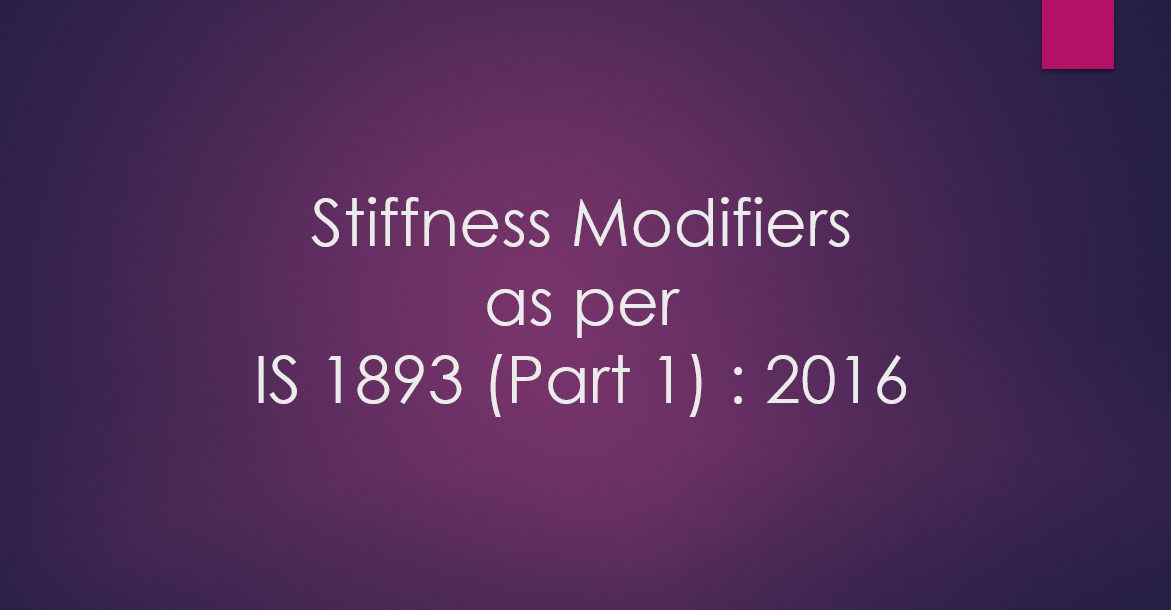The concept of stiffness modifiers is introduced for the first time in IS 1893 (Part 1) : 2016. The clause no. 6.4.3.1 of the code defines requirements for structural analysis. It is mentioned in the clause that for structural analysis, we should consider reduced moment of inertial for RCC structures. For columns, 70 percent of Igross should be considered and for beams, 35 percent of Igross to be considered. This clause has generated many questions among the group of structural engineers. The overall objective of writing this article is to collate views/suggestions from the wider group of engineers. In the following section, I have attempted to give answers to few questions, received from different engineers. The answers are given for buildings having height less than 50 m. The comparison of stiffness modifiers with IS 16700 : 2017 & IS 15988 : 2013 will be done in the subsequent article.

Q-1 Why stiffness modifiers are introduced in the code?
Before this clause, in the structural analysis, we were considering 100% of moment of inertia for RCC beams and columns. In RCC member, the cracks will generate in the tension zone of concrete due to application of different loads. Due to these cracks, the moment of inertia of RCC member will be lesser than the gross moment of inertia. Hence, to account for the reduced moment of inertia of the cracked section, the concept of stiffness modifiers is introduced in the code.
Q-2 Why stiffness modifier value is higher for column than beam?
The pattern and extent of cracks will vary substantially from structure to structures and members to members even in a similar structure. It is very difficult to assign the unique values of the stiffness modifiers for different members. The values which are suggested in the code are based on the numerous experiments and might have been referred from different international standards. The stiffness modifier value for column is higher than the beam since the columns will have higher axial compression than the beam. Hence, the extent of cracks would be lesser in the columns as compared to the beams. Hence, the stiffness modifier value for column is higher than the beams.
Q-3 What impact stiffness modifiers will make on overall analysis?
There will be two major impacts in the structural analysis results as compared to the model using 100% of gross moment of inertia:
1) Since we are considering the reduced moment of inertia, the overall stiffness of the structure will reduce. Due to the reduced stiffness, the structure will be relatively flexible and hence would attract the lower seismic forces.
2) Drift of the structure will increase because it is relatively flexible.
Q-4 Are stiffness modifiers required only for analysis or for design as well?
The stiffness modifiers should be considered only for the structural analysis. The analysis results to be derived considering the stiffness modifiers. The structural design to be done with the conventional procedure considering the analysis results.
Q-5 Should we consider stiffness modifiers for all load cases or only for seismic loads?
The stiffness modifiers mentioned in IS 1893 (Part 1) : 2016 are only for ultimate condition, i.e. for seismic load case. The same modifiers should not be considered for the other load cases.
Q-6 Is it required to consider the value of torsional stiffness modifiers?
As per IS 1893 (Part 1) : 2016, no reduction to be considered for torsion constant, i.e. 100% of torsion constant to be considered for the structural analysis.
Q-7 What will happen if we consider unique stiffness modifiers for both serviceability and ultimate conditions?
Generally, the stiffness modifiers are different for serviceability and the ultimate conditions. As discussed above, the stiffness modifiers defined in IS 1893(Part 1) : 2016 are for the ultimate condition. If we consider the same stiffness modifiers for the serviceability condition as well then the moment at beam column junction will be higher and the span moment will be lesser as compared to the model without stiffness modifiers. In my opinion, the span moment may err on the unconservative side, if we consider the same stiffness modifiers for the serviceability condition.
Q-8 Is it required to consider stiffness modifiers for the shear wall and slab?
At present, I think it is not required for the shear wall & slab as per IS 1893 (Part 1) : 2016. It is only required for RCC beams and columns.
Q-9 Should we consider stiffness modifiers for design of foundations?
As mentioned above, the stiffness modifiers to be considered only for seismic load case. The structural analysis is to be performed with the seismic loads having stiffness modifiers. Thereafter, the analysis results should be used for design of the foundation.
Concluding remarks:
Consideration of the stiffness modifiers will reduce the seismic demand on the structure. But at the same time, it will result in relatively higher drifts due to increased flexibility of the structure. The stiffness modifiers value should be different for the serviceability and the ultimate conditions. The stiffness modifiers are to be used only for structural analysis. The comparison of stiffness modifiers with IS 16700 : 2017 & IS 15988 : 2013 will be done in the subsequent article. The above mentioned answers are based on my understanding. If you have further questions / difference of opinion, then please share details in the below comment box.
Bhavin Shah
Founder & CEO, SQVe Consultants
